This article details the process I went through purchasing a used boat, listed through a yacht broker and purchased through a buyer’s yacht broker. S/V Counterpoint is my first and only boat purchase so Caveat Empor.
Purchasing a used boat is a lot more like buying a house than it is buying a car. Actually, in my experience it’s even more involved as you’ll see if you read on.
Generally the purchasing process goes as follows:
- Find a boat you like and decide to make an offer
- Negotiate with the seller until you have an accepted offer
- Write a check to place your deposit
- Purchase a Survey and Sea Trial
- Verify you can insure the boat
- Negotiate again based off of the survey findings
- Complete the purchase
Find A Boat and Decide to Make an Offer
Having all but given up my search I stumbled upon S/V Counterpoint in April of 2019. I’ve detailed my boat search criteria in this article but I wasn’t even at the yard to look at Counterpoint – I was evaluating a Swan 53 to determine if I could stand up below. (I could not.)
But while at lunch Francis (my broker) and I found Counterpoint on yachtworld listed at the same yard. A Bristol 45.5 was the only model left on the short list. Why? I’ll let 2019 TJ explain – this is excerpted from an email I sent to some friends I leant on as advisors during the purchase process:
… I have stepped aboard something like 40 different makes I considered during my boat search. Many were eliminated within two minutes due to headroom (Tayana 48! Beneteau 50! HR46. Jeanneau 49i. Swan 53!!!). Factor in my additional pickiness and only 2 models remained: Catalina 42 MkII and Bristol 45.5.
Try as I might I can’t see the Catalina 42 as anything other than a starter boat for me; a boat that I’d outgrow quickly. Not a boat that I’d want to take offshore singlehanded and I’ll be there within 5 years for sure. Very little room for cruising stores. I love the pullman berth forward. I thought the Catalina 470 might be the solution but that aft berth setup is ridiculous: no standing headroom at all!
The 45.5 has been circumnavigation tested and I could see myself comfortably heading offshore aboard. It’s a solid blue water boat with the potential to sail really well with the right sails. And I can stand up straight anywhere there is flooring in the cabin. Even with shoes on!
After more than 6 months of searching I’m left with a Bristol 45.5 or shift my search into the 50+’ range. After seeing a majority of the 45.5s on the market I was pretty convinced I’d have to go 50+. And that would probably mean more money which would mean walking away from the search for at least another season. Or double my price range: the Outbound 46 is an expensive boat!
In the meantime I was considering picking up a C42 “starter boat” if I could find a good one (deep draft, conventional main) for under 100k.
But I was at the yard anyway so I checked out Counterpoint. None of the additional things I disliked about the other, more expensive, 45.5s I’d seen (painted mast, extra teak, in mast furling). Which could be had for 100k. Definitely not a starter boat but a boat that is well set up enough that I could cruise the New England coast for the next few years while I get her fully prepped for further afield.
So here I am. No boat. A starter boat. Or a Bristol 45.5.
Now you can tell me I’m crazy.
(They did tell me I’m crazy, and why, at length…)
Sometime this season I will put together a walk through video of S/V Counterpoint; right now she’s on the hard in the cold and that just would not do. For now if you want to know more about Counterpoint as I bought her you can check out this PDF of the original listing:
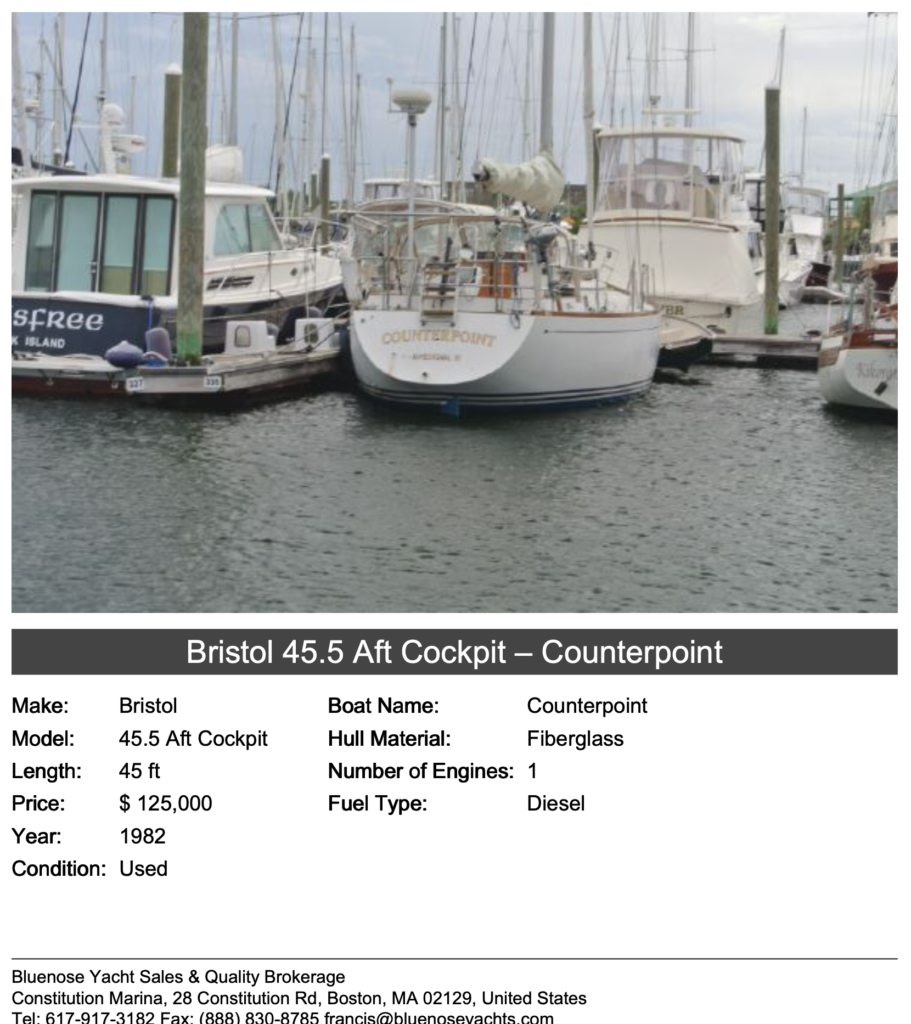
At this point I had talked myself into at least making an offer.
Negotiate with the Seller to arrive at an Accepted Offer
This is where a buyer’s broker is great to have. Francis pulled comparable sales of Bristol 45.5 over recent years. And helped me strategize to arrive at 100k which is a price at which I would be willing to continue moving forward.
Anyway, it went like this:
- Listed Asking: 125k
- I Offer: 85k
- Seller Counter: 105k + Dockage for the season
- I Counter: 98k
- Seller Accepts
And then it’s officially time to set up a survey and sea trial.
Other Homework for Counterpoint
At this point I’ve only been aboard Counterpoint once. But because Counterpoint was so promising that day Francis and I spent a bunch of time looking through her performing our own ad-hoc survey. Francis got out his moisture meter and looked over the decks. We looked all around for signs of leaks. Stared at the diesel engine. Rooted around in the bilge looking for problems.
If you’re savvy you can read all about performing your own pre-survey survey in this book (affiliate link).
As far as we could tell the decks were dry.
The diesel didn’t make much sense; it was a nearly 40 year old diesel that looked it’s age. But the listing said it had 550 hours. The hour meter on the engine control panel said 361 hours. The diesel had brackets on the front that indicated that, at some point, it had engine driven refrigeration which usually means lots of engine hours.
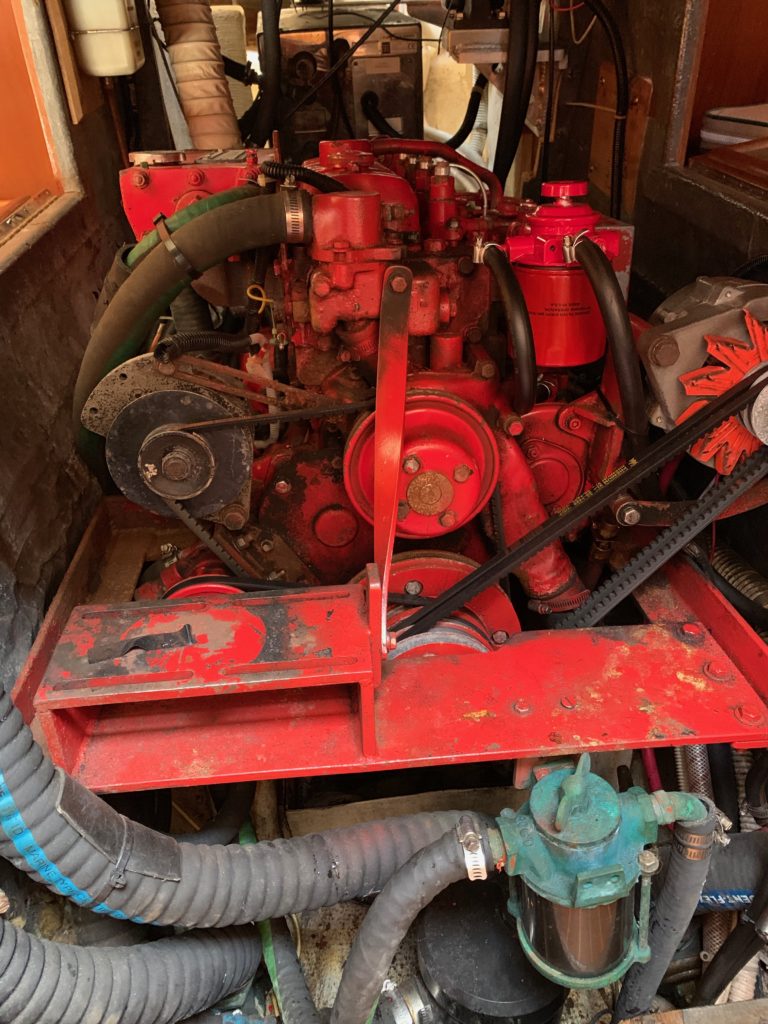
Definitely needed to find out more about the diesel from the survey!
I honestly don’t remember if I spent a bunch of time looking at the tanks because I had read online that they could be problematic on this boat or if I went online after seeing Counterpoint to read about Bristol 45.5 fuel tank problems. Either way before hearing any response from the seller I had done a bunch of reading about the expense of replacing metal fuel and water tanks for older boats whose tanks were in the bilges.
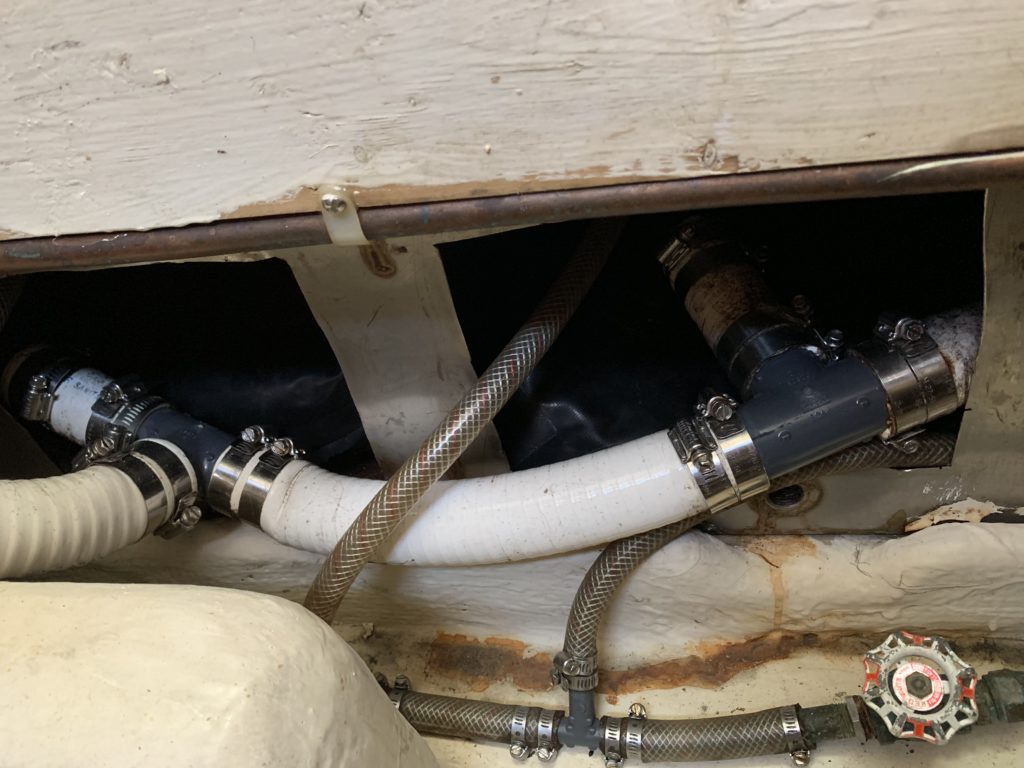
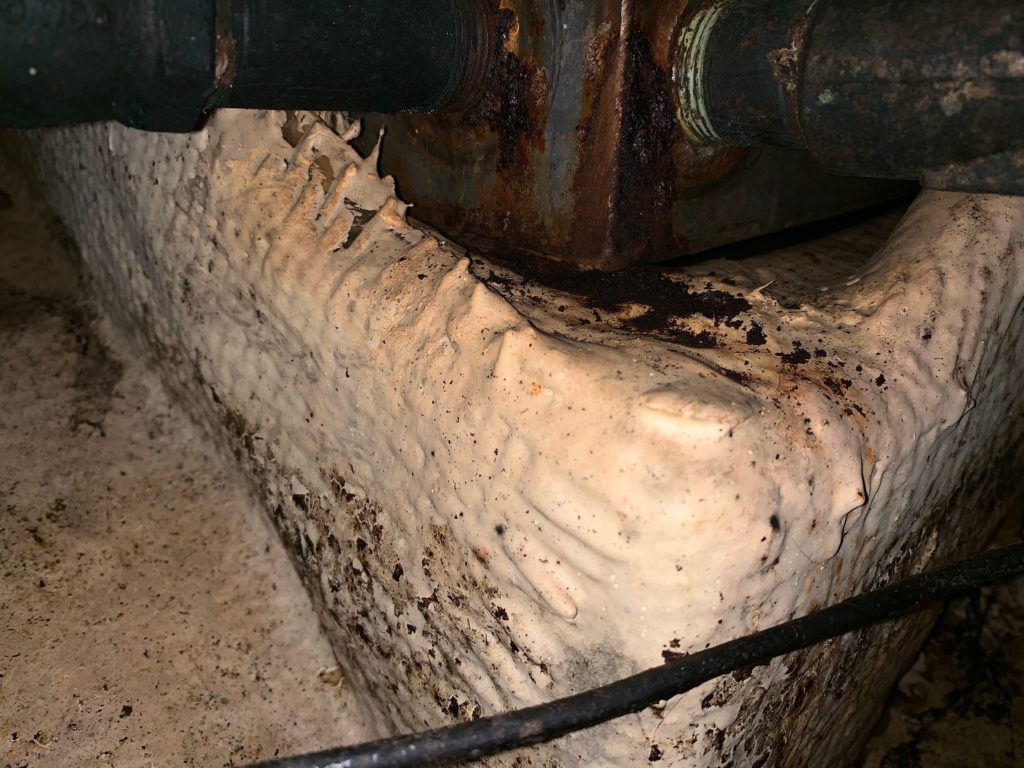
The tanks were my biggest concern. I began reaching out to boatyards to get quotes for replacing the tanks. I also went online in Bristol forums to see if I could find other owners who had the tanks replaced and see how much they’d spent. During negotiations (both pre and post survey) I wanted to have good numbers to work from. I went so far as to download a drawing of a Bristol 45.5 AC, add diagrams for the approximate locations of the tanks to include with my request for quotes:

Lastly I took everything I knew about the boat, wrote it up and sent an email to every sailor whose opinion about boats I respected. That email thread is where I got 2019 TJ’s thoughts about deciding to make an offer on Counterpoint quoted above. I talked about the tank and the diesel questions. I asked for recommendations for surveyors and for boat yards.
I had 10 sailors on that thread. The thread had 10 responses before my offer was accepted and the thread eventually grew to 43 emails. I received lots of yard and surveyor recommendations. I sent the survey to that thread once it was available. Having 10 sailors whose opinion I respected discussing the same listing, pictures and survey was a great aid to figuring out if and how to proceed with the purchase.
Survey and Sea Trial
I am a belt and suspenders kind of guy; especially when it comes to sailing. Given all of the questions I had about Counterpoint even before my offer was accepted I decided I’d get two surveys done. I picked the most highly recommended surveyors from my email thread and booked surveys with both of them. It would cost twice as much but I was willing to pay for the additional peace of mind.
I scheduled things so that the first survey would happen before the boat splashed for the season. The second survey would be scheduled after the boat splashed and would include a sea trial. We didn’t have a firm splash date, especially given work that might arise from the first survey, so the second survey wasn’t firmly scheduled.
Even with all the legwork I had done for the purchase of Counterpoint I was still fairly skeptical I would end up buying the boat.
Jeff Stone, my first surveyor, picked up on my uncertainty. Mid survey he asked me if I wanted him to switch to an “abbreviated” survey format and save some money. I thought about it but decided a complete survey would be better for negotiating and insurance purposes.
The survey’s executive summary:
“Counterpoint” was found in good condition structurally and cosmetically. The engine condition is unknown, and it is suggested here, that a qualified diesel engine mechanic review it. The bonding system should be reviewed and all thru hull valves serviced and inspected. The port aft fuel tank is suspect. Though not presently leaking, the oxidation on the inboard aft corner of that tank is cause for concern, especially in view of the fact that the port water tank appears to have failed and has had a bladder inserted within.
The Bristol 45.5’s are a well-built and sturdy vessel. Attention to the larger issues will assure a long life ahead. These issues are common to any older vessel.
The full survey brought a few things to the fore:
- Seacocks were quite corroded and frozen. We noticed them at the showing but we didn’t try to force them until the survey
- The shaft seal and max prop would need servicing
- The bonding system should also be evaluated
But really all the surprises were small next to the scale and expense of the tank replacement project and potential diesel engine replacement.
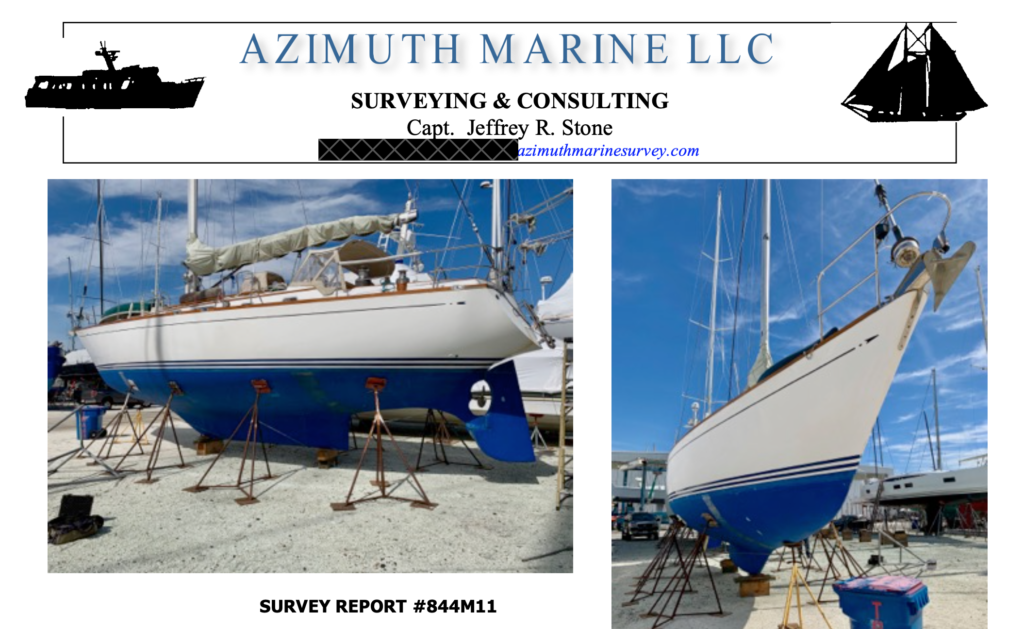
Armed with those quotes we send the survey recommendations to the seller to prepare for the next round of negotiations.
Verify Insurability
Once you have a survey you should make sure you can get insurance for the boat you’re trying to purchase.
More than a handful of sailors I know have had trouble finding insurance during and after their purchase. In one case the deal did not go through because of insurance. Another friend couldn’t move the boat without a licensed captain aboard for more than a year due to insurance restrictions. But the worst was a friend who could not insure his boat for delivery because of the season – he had to wait out hurricane season before he could take delivery of the boat.
Your surveyor and broker can suggest insurers.
I won’t bore you with the details of my insurance search as the insurer I chose no longer insures yachts in the USA.
Post Survey Negotiations
While we waited to hear from the seller and in tandem with finding insurance for Counterpoint I chased around marine vendors and got quotes for replacing the tanks in the bilge (2 water and 3 diesel) and the diesel engine. $45k and $25k, respectively. After confirming these quotes with a second yard my plan was to use those quotes to negotiate hard.
I figured I’d use the first survey for negotiation; I would use the second survey and sea trial as a final gut check before finishing the deal. The way I figured at $98k the seller had already split the cost of the tank replacement with me, 50/50. My goal in this round of negotiation would be to get the seller to split the cost of the seacock and diesel replacement with me. If I couldn’t negotiate appropriate concessions, somewhere between 70-80k, I’d walk before the second survey.
Instead of the anticipated time to complete some of the survey recommendations and a back and forth the seller countered with $78k AS IS.
78k wasn’t as “AS IS” as most such offers because I’d already done a professional survey. I felt like it was an opportunity not to be missed so I got in touch with Francis and strategized. We decided that, so long as we could run the diesel at the dock with the boat in the water and send an oil sample out for analysis, I would not get more concessions than were currently on the table no matter what the sea trial and survey found. So we countered 70k with the oil analysis (which would involve running the engine up to temperature at the dock).
The seller countered $75k and I accepted.
Counterpoint Final Check
I have to admit, once I decided to counter with an “as is” offer I became quite invested in the purchase. But I still needed to run the engine at the dock, collect the oil sample and get it analyzed.
So we did and everything, including the oil analysis, checked out so it was time to finish this deal.
Closing
At this point all that is left to do is wait for the appointed day, sign the documents and write the final check.
Then you take your new boat out for a sail!
Total Costs:
What was the total cost with everything? I’m glad you asked:
| Cost | Description |
|---|---|
| $9,800 | Counterpoint Deposit/Escrow |
| $1,080 | Survey |
| $28 | Engine Oil Analysis |
| $65,200 | Closing Check |
| $15.00 | Cashier Check Fee |
| $1,467.80 | Counterpoint Insurance Premium |
| $92.00 | Coast Guard Documentation |
| $77,682.80 | Total |
For a boat that the final negotiated price was $75,000 a total expenditure of $77,682.80 is only 3.6% on top of what I paid for the boat. Now, as I mentioned an expensive refit was already in the works but this is what it cost me before I was able to take S/V Counterpoint out on my own for the first time.
My purchase of S/V Counterpoint came with a slip for the season, a $8000 value; essentially another 10% savings.
Spoilers
I’m going to provide a bunch of information on the work I’ve done and had done on Counterpoint since I purchased her in subsequent articles. But really quickly I wanted to follow up on a few key concerns that I had discussed above:
Tanks
The tanks were replaced the first winter I owned Counterpoint. They were more of a problem than I had originally thought. The fuel was dirty and kept clogging up fuel filters at the end of the season. And the gunk in the filters looked a lot like rust.
I’ll go into the details of the tank replacement in the refit article but the short story is that it was $50k well spent and the quote was fairly accurate as well.
Diesel Engine
I had the diesel engine inspected by a mechanic. It passed with flying colors. The first and second season’s oil analysis also turned up nothing abnormal.
I also got the engine hours story from the seller well after completing the purchase. The engine was rebuilt by a boat yard a few years before; they hadn’t tightened the oil filter adequately during the commissioning oil change and the oil leaked out and the diesel stopped. That yard performed the rebuild at their expense.
Other than the fuel problems the diesel has started up every time I turned it over.
I’ll still probably replace the engine if I ever take Counterpoint on a circumnavigation. The engine was run without oil to the point it had to be rebuilt, it’s still covered in rust but the coup-de-grace is that it’s so old that many replacement parts for it can no longer be purchased.
Thru Hulls & Bonding System
While the tank work was going on I had the thru-hulls and seacocks replaced. Again I’ll talk more about this in the refit article but this work was definitely worth the peace of mind.
S/V Counterpoint Article Series
If you care to read more about my journey buying Counterpoint,
- How I chose my Bluewater Sailboat
- My Bluewater Sailboat Purchase Process (this article)
- Fuel Tank and Water Tank Replacement Project
- My Bristol 45.5’s 40 Year Refit
- 45’ Blue Water Boat Cost of Ownership
- S/V Counterpoint: Bluewater Sailboat Video Tour
Leave a Reply